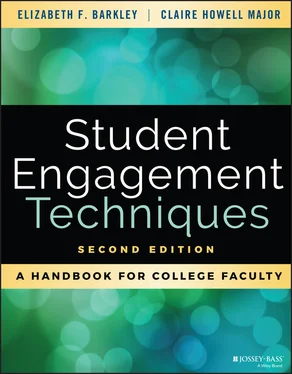Elizabeth F. Barkley - Student Engagement Techniques
Здесь есть возможность читать онлайн «Elizabeth F. Barkley - Student Engagement Techniques» — ознакомительный отрывок электронной книги совершенно бесплатно, а после прочтения отрывка купить полную версию. В некоторых случаях можно слушать аудио, скачать через торрент в формате fb2 и присутствует краткое содержание. Жанр: unrecognised, на английском языке. Описание произведения, (предисловие) а так же отзывы посетителей доступны на портале библиотеки ЛибКат.
- Название:Student Engagement Techniques
- Автор:
- Жанр:
- Год:неизвестен
- ISBN:нет данных
- Рейтинг книги:3 / 5. Голосов: 1
-
Избранное:Добавить в избранное
- Отзывы:
-
Ваша оценка:
- 60
- 1
- 2
- 3
- 4
- 5
Student Engagement Techniques: краткое содержание, описание и аннотация
Предлагаем к чтению аннотацию, описание, краткое содержание или предисловие (зависит от того, что написал сам автор книги «Student Engagement Techniques»). Если вы не нашли необходимую информацию о книге — напишите в комментариях, мы постараемся отыскать её.
— — — —
Student Engagement Techniques
"Student Engagement Techniques
"Student Engagement Techniques
"This book is an essential resource for faculty seeking to better engage with their students. Anyone seeking a clear, research-based, and actionable guide needs a copy of Student Engagement Techniques on their shelf!"
Student Engagement Techniques — читать онлайн ознакомительный отрывок
Ниже представлен текст книги, разбитый по страницам. Система сохранения места последней прочитанной страницы, позволяет с удобством читать онлайн бесплатно книгу «Student Engagement Techniques», без необходимости каждый раз заново искать на чём Вы остановились. Поставьте закладку, и сможете в любой момент перейти на страницу, на которой закончили чтение.
Интервал:
Закладка:
Memory
Once students learn something, we want them to remember it. There are currently several different models describing memory, but a basic and generally accepted classification divides memory into two main types: short term and long term. Short-term memory gives continuity from one moment to the next and allows us to carry out hundreds of tasks each day by holding the data we are dealing with at the moment, but then letting it go so that our brain can turn its attention to other things. Short-term memory is where the brain works with new information until it decides if and where to store it more permanently. While short-term memory is supported by transient neuronal networks and functions as temporary storage, long-term memory is retained for greater lengths of time—days, decades, even an entire lifetime. It is structurally different from short-term memory in that it is maintained by permanent cellular changes that have been created by neuronal connections distributed throughout the brain. We want students to remember important new learning in the long term, so how do short-term memories become long-term memories? Research suggests that there is a special window in time during which this transition occurs: the time needed for neurons to synthesize the necessary proteins for “long-term potentiation” (LTP). An initial stimulation triggers communication across the synapse between two neurons; further stimulation causes the cells to produce key proteins that bind to the synapse, cementing the memory in place. If the memory is to last for more than a few hours, these proteins must bind to specific synapses and actually change the cellular structure.
The criteria by which short-term memory determines whether or not information should be stored for the long term is complex. Information tied to survival or information that has a strong emotional component has a high likelihood of being permanently stored. In classrooms, where these two elements are generally minimal or absent, other factors come into play. One important factor is whether or not the information “makes sense”—does it fit with what the learner already knows about the way the world works? When students say that they don't understand, it means that they cannot make sense of what they are learning, and hence probably won't remember it. The other important factor is whether or not the information “has meaning”—is it relevant, is there some reason the learner has for remembering it?
We remember some information just because it made sense, even though it isn't particularly meaningful to us (this is the kind of data people may recall when they are doing crossword puzzles or playing games such as Trivial Pursuit). We also remember information that didn't make sense to us just because it had meaning (it was important for us to memorize it in order to pass a test). Of the two criterion, meaning is more significant. For example, telling a student that they need x number of units in their academic major for a degree at your institution, but y number of units if they attended a different institution in another state “makes sense,” but the student will have a higher likelihood of remembering the number of units at her own institution because it is more meaningful and relevant to her educational plans. Thus, when new learning is readily comprehensible (it makes sense) and can be connected to past experiences (it has meaning), retention is dramatically improved (Sousa, 2006, pp. 49–51).
Retention
The process by which long-term memory preserves learning in such a way that it can be located, identified, and retrieved accurately in the future is called “retention.” Retention is influenced by many factors, but a critical factor is adequate time to process and reprocess information so that it can be transferred from short- to long-term memory. The encoding process from short-term to long-term memory that allows for retention takes time, and usually occurs during deep sleep. Since research on retention shows that the greatest loss of newly acquired information or a skill occurs within the first 18–24 hours, if a student can remember the information after 24 hours, there is a higher likelihood that it is now in long-term storage. If a student cannot remember the information after that period, it is most likely not permanently stored and will not be retained.
What Is Active Learning?
Although active learning's roots run deep from an historical perspective, the term active learning was popularized in the late twentieth century with Bonwell and Eison's (1991) ASHE-ERIC Report titled “Active Learning: Creating Excitement in the Classroom.” Several definitions of active learning exist, and the following are just a few:
Anything that involves students in doing things and thinking about the things they are doing (Bonwell & Eison, 1991)
A process whereby students engage in activities, such as reading, writing, discussion, or problem-solving, which promote analysis, synthesis, and evaluation of class content (The Regents of the University of Michigan n.d.)
A method of learning in which students are actively or experientially involved in the learning process (Weltman & Whiteside, 2010)
In Chapter 1of this book, as well as in our book Interactive Lecturing: A Handbook for College Faculty , we argue for a broad understanding of active learning rather than simply associating the term with a specific instructional approach, activity, or technique (Barkley & Major, 2018, p. 21). We also suggest that active learning involves making students dynamic participants in their own learning in ways that require them to integrate new information into their personal knowledge and experience. In general, we suggest that active learning happens when students are engaged in their learning in one or more of the following ways (Barkley & Major, 2018):
Choosing sophisticated learning strategies
Seeking deep, conceptual understanding rather than surface knowledge
Finding connections that demonstrate personal relevance
Using self-regulatory and metacognitive strategies
Seeking to share personal perspectives
Seeking to understand others' perspectives
Demonstrating curiosity, interest, and enthusiasm
Offering input or suggestions
Seeking out additional and further opportunities for learning (p. 21)
Active learning puts into practice over a half-century of research that demonstrates that to truly learn, we need to take an idea or a concept or a problem solution and make it our own by working it into our personal knowledge and experience. What it boils down to in some ways is intellectual effort on the part of the student. It also encompasses the strategies that learners use.
Researchers have found that some learning strategies make some students more successful than others, and these strategies typically are examples of active learning. Educational psychologists Marton and Säljö (1976), for example, articulated such a concept in their notion of learning approaches. These researchers asked students to read materials from an academic text and then to describe what they had read. The researchers identified evidence of qualitative differences in students' reading outcomes: some students fully understood the argument and the evidence to support it, others partly understood the message and support, and still others could remember only various details. Marton and Säljö characterized the approaches in which students focused on what the authors meant and actively connected information to what they already knew as “deep learning approaches.” They characterized approaches in which students aimed to memorize facts and focus on discrete elements in the reading as “surface learning approaches.” Marton and Säljö furthered this conception of deep learning when they asked adult learners what they understood about “learning,” and made distinctions between different levels of their understandings. Säljö (1979) categorized answers in a hierarchical pattern, observing that each higher conception implied all that preceded it:
Читать дальшеИнтервал:
Закладка:
Похожие книги на «Student Engagement Techniques»
Представляем Вашему вниманию похожие книги на «Student Engagement Techniques» списком для выбора. Мы отобрали схожую по названию и смыслу литературу в надежде предоставить читателям больше вариантов отыскать новые, интересные, ещё непрочитанные произведения.
Обсуждение, отзывы о книге «Student Engagement Techniques» и просто собственные мнения читателей. Оставьте ваши комментарии, напишите, что Вы думаете о произведении, его смысле или главных героях. Укажите что конкретно понравилось, а что нет, и почему Вы так считаете.












